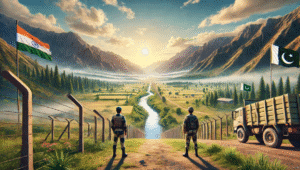India-Pakistan Ceasefire: 5 Strategic Challenges Modi Must Conquer to Protect Sovereignty and Diplomacy
In light of U.S. President Trump’s unexpected announcement of a “full and immediate ceasefire” between India and Pakistan, Prime Minister Modi faces a complex strategic challenge. India has historically rejected third-party mediation, viewing it as a threat to its sovereignty and a reminder of past foreign interventions that often ignored Indian interests. The public U.S. involvement risks re-hyphenating India with Pakistan, undermining New Delhi’s long-standing efforts to establish itself as a standalone global power.
While India has tacitly accepted discreet third-party crisis management—like the UAE’s quiet role in 2021—it fiercely opposes any formalized external role in dispute resolution. Modi must now manage domestic nationalist sentiments while preserving strategic partnerships, especially with the U.S., without compromising India’s diplomatic autonomy. The path forward involves clearly delineating between de-escalation and dispute resolution, strengthening multi-alignment strategies, and re-engaging Pakistan through controlled diplomatic channels. This episode is a test of India’s ability to uphold its sovereign principles amid increasing global interference.

India-Pakistan Ceasefire: 5 Strategic Challenges Modi Must Conquer to Protect Sovereignty and Diplomacy
In a geopolitical twist, U.S. President Donald Trump’s unexpected announcement of a “full and immediate ceasefire” between India and Pakistan has reignited debates about third-party mediation in the Kashmir conflict—a red line for New Delhi. While Pakistan’s Prime Minister Shehbaz Sharif lauded Trump’s “proactive role,” India’s terse statement omitted any reference to U.S. involvement, underscoring its historical resistance to external interference. This dissonance highlights Prime Minister Narendra Modi’s precarious balancing act: averting escalation while safeguarding India’s hard-earned diplomatic autonomy.
The Ghosts of History: Why India Rejects Mediation
India’s aversion to third-party mediation is rooted in sovereignty concerns and a bitter history of unresolved interventions. After the 1971 war, the Simla Agreement cemented a bilateral framework for disputes, reflecting India’s resolve to shed its post-colonial reliance on global powers. Past mediations—from UN resolutions in 1948 to Soviet-brokered talks in 1966—often left India feeling shortchanged, cementing a belief that external actors prioritize stability over justice.
For India, Kashmir is not merely territory but a symbol of its identity as a sovereign, rising power. Accepting mediation risks legitimizing Pakistan’s claims and undermining decades of effort to “de-hyphenate” itself from its neighbor—a strategy aimed at positioning India as a global leader rather than half of a regional rivalry.
Crisis Management vs. Policy Consistency: The UAE Precedent
While India publicly rejects mediation, backchannel diplomacy has occasionally played a role during crises. The UAE’s behind-the-scenes role in brokering the 2021 ceasefire, acknowledged by Pakistan but unconfirmed by India, reveals a pragmatic duality: New Delhi tolerates discreet third-party facilitation to de-escalate conflicts but refuses to formalize it.
This ambiguity allows India to manage crises without conceding ground on principle. However, Trump’s overt proclamation disrupts this delicate balance, forcing Modi’s government into a corner. Acknowledging U.S. involvement could signal weakness; denying it risks alienating a key ally.
The Re-Hyphenation Dilemma: Why It Matters
“Re-hyphenation”—the renewed coupling of India and Pakistan in global discourse—threatens India’s strategic narrative. By framing the ceasefire as a U.S. achievement, Trump inadvertently reinforces the perception of South Asia as a volatile theater requiring Western stewardship, undermining India’s self-image as a mature, independent power.
For Modi, the challenge is twofold:
- Domestic Optics: Nationalist sentiment runs high, with citizens questioning why a foreign power announced India’s military decisions. Silence could fuel accusations of capitulation.
- Global Reputation: Accepting mediation might embolden Pakistan to internationalize Kashmir, while resistance could strain U.S.-India relations at a time when Washington remains a critical partner.
Pathways Forward: Modi’s Tightrope Walk
To navigate this quagmire, India must:
- Clarify the Narrative: Issue a definitive statement distinguishing crisis de-escalation (where limited third-party roles are tolerated) from dispute resolution (strictly bilateral).
- Leverage Strategic Partnerships: Strengthen ties with QUAD and European allies to dilute reliance on any single mediator.
- Revive Diplomatic Channels: Reopen official talks with Pakistan to preempt future crises requiring external intervention.
Conclusion: Sovereignty in the Shadow of Crisis
The ceasefire, while a tactical win, exposes India’s vulnerability to geopolitical narratives beyond its control. Modi’s response will shape whether this episode becomes a footnote or a precedent. As global powers increasingly intervene in regional disputes, India’s ability to assert its agency—without isolation—will define its rise on the world stage. The question lingers: Can India uphold its principles while navigating an era of great-power competition?
You must be logged in to post a comment.